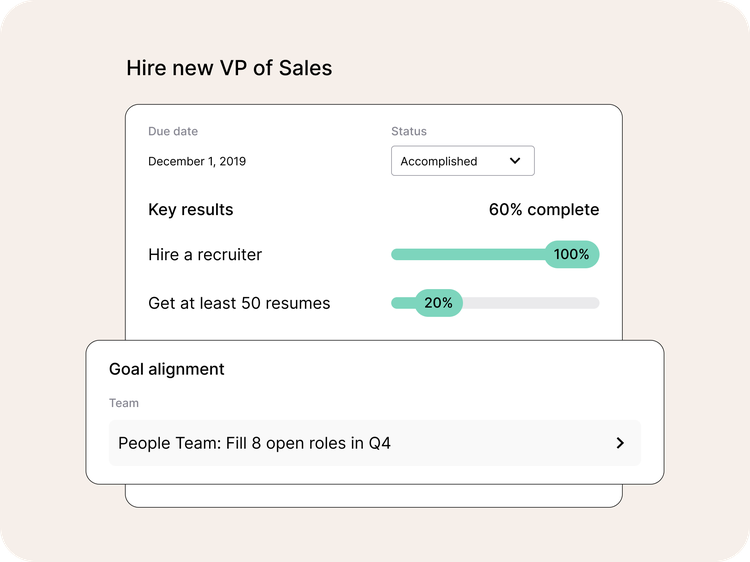
Article

Written by

Writer, Culture Amp
Setting meaningful employee performance goals is a crucial first step toward creating a fair and motivating performance management process and retaining your best people. Clear goals help employees feel motivated and confident while also helping to prevent unconscious biases from seeping into the performance review process. Specifically, goal setting helps reduce recency bias by providing a longer-term view of employee performance and mitigating the tendency to overemphasize recent events in performance reviews.
As a manager, you hold an influential position in ensuring successful goal-setting:
By empowering your direct reports to set their own goals, you help them foster a sense of agency and ownership of their professional path, which will likely translate to higher engagement.
To help you support your employees in creating impactful performance targets, we’ve outlined a framework for employee goal-setting, including plenty of performance goals examples you can reference in the process. Use these tools to guide your direct reports in setting goals that are effective, engaging, and aligned with broader organizational objectives.
The goal-setting framework we love and most recommend at Culture Amp is objectives and key results (OKRs).
OKRs start with a high-level objective, like “Launch a new product feature in Q1." Then, they list key results that an individual can use to evaluate success. For this example, our key results might look like this:
OKRs are especially powerful for aligning and connecting your employees' individual goals to the company's broader vision. For example, when setting goals in the Culture Amp platform, you can easily align personal goals to broader department goals, as seen in the image below.

When done properly, OKRs create the critical alignment necessary for employees to understand how their day-to-day responsibilities impact overall business success. By creating a unified, shared vision of success, you can help employees find purpose in their work, drive engagement, and foster a culture of high performance.
After setting your OKRs, we recommend using SMART goals to evaluate your employees' goals. Think of SMART as a goal-setting tool to assess a goal's strength, whereas OKRs are the broader framework that encourages alignment.
In general, SMART goals allow your employees to develop a deep and precise understanding of the goal, its purpose, how to measure success, and how it connects to broader company priorities.
Goals that meet the SMART criteria are:
Performance management example of a not-so-smart goal: Run 2x more webinars and increase attendance and satisfaction rates.
Performance management example of a SMART goal: Plan and execute 4 customer education webinars by April 10th, with 25+ attendees and 80%+ satisfied/very satisfied rating for each webinar.
Using the OKR framework, this goal may be included as a key result for an objective like, “Increase customer engagement and satisfaction through educational initiatives to enhance product knowledge and foster community relationships.”
Goals that meet the SMART criteria and follow the OKR framework are good examples of measurable, aligned goals for employees. We also encourage involving your direct reports in this goal-planning process as it helps improve employee commitment and motivation, as people are generally more invested in goals they have helped set up themselves – rather than just having them “handed” to them. It also expands their perspective to include the team's workflow and broader company performance targets.
Here are some sample goals you can use to help you or your direct reports craft more effective quarterly goals.
Objective: Increase brand authority through thought leadership content.
Key Results:
Objective: Boost conversion rates by enhancing follow-up efficiency.
Key results:
Objective: Strengthen customer retention through proactive engagement.
Key results:
Objective: Improve platform performance by reducing technical debt.
Key results:
Objective: Enhance the employee onboarding experience for new hires.
Key results:
Objective: Elevate brand storytelling through community engagement.
Key results:
Objective: Improve user satisfaction through impactful design updates.
Key results:
Objective: Build stronger prospect relationships through personalized outreach.
Key results:
Now that you’ve included your direct reports in the goal-setting process, provided them with examples of measurable goals, and worked with them to diversify the types of goals they’re setting, what’s next? Check in with employees about how goal-setting is going.
Culture Amp recommends asking these seven questions in your organization’s next employee survey or pulse survey to measure how goal-setting is perceived at your company:
Once your survey ends, follow these steps to get the most out of your data and ensure your employees find your business’s approach to goal-setting effective:
By continuously iterating and involving employees in the process, you can foster a goal-setting culture that drives alignment, accountability, and performance across your organization.
Another way to improve your goal-setting strategy is with performance management software. Investing in dedicated goal-setting solutions sends a strong message to employees that setting and tracking goals is a top priority for your business. Performance management software offers other perks, too – greater visibility into goal progress and roadblocks, better alignment, increased accountability, and data-driven decision-making.
Sound enticing? Here are a few performance management software tools to consider investing in for improved performance:
Goal-setting software helps employees treat goals with the importance they deserve. Entering individual goals into a centralized system and aligning them with broader organizational performance targets gives employees a clear definition of success to strive for. This transparency drives accountability and alignment while also ensuring employee contributions support overall business objectives.
For managers, the tool provides even more benefits. It allows you to:
By streamlining goal management, goal-setting software fosters alignment, accountability, and continuous improvement.
Giving and receiving constructive feedback is a key element of the performance management process. When delivered at the right time, feedback can inspire employees to improve and even push them to exceed their goals. But too often, feedback is mentioned in passing without proper follow-up and fails to drive meaningful action.
A formal feedback tool can change this by storing all constructive feedback, whether it comes from you or your employees' peers, in one centralized location. Saving feedback in an accessible place keeps it top of mind throughout the year, making it easier for you to coach employees effectively and increasing the likelihood that they’ll take the feedback to heart.
Need help crafting actionable and constructive feedback? Explore our post on "Employee feedback: Examples to guide and drive development" for best practices on fostering a culture of continuous improvement within your team.
One of the best ways to stay on top of goal progress and help employees as issues arise is through ongoing communication via regular 1-on-1 meetings. A tool like Culture Amp’s 1-on-1 conversations can enhance these weekly conversations by allowing you to:
Storing this information in one place ensures accountability, prevents important details from slipping through the cracks, and keeps conversations focused and productive so you can make the most of your time together. Regular 1-on-1s also provide employees with a dedicated space to discuss goal progress, surface any issues holding them back, and brainstorm the best path forward. These conversations help them stay on track and get the support and resources they need to achieve their objectives.
When it’s time to conduct formal performance reviews, comprehensive performance management software can simplify the process and ensure evaluations are more accurate and fair. Plus, it can help minimize bias in performance evaluations, allowing you to deliver more equitable reviews. Tools like 360-degree feedback (incorporating input from self-evaluations, peers, and managers), detailed goal progress tracking from the entire review period, and formal calibrations can help you build trust and credibility in the performance review process.
As you take steps to elevate your performance review process, we hope you’ll remember a few key takeaways from the performance management examples shared in this article:
Investing in goal-setting tools like Culture Amp’s OKR software can help your business turn business objectives into motivating employee goals. If you’re looking to learn even more about effective goal-setting and best practices for motivating your employees, we recommend checking out HR's complete guide to performance management.
